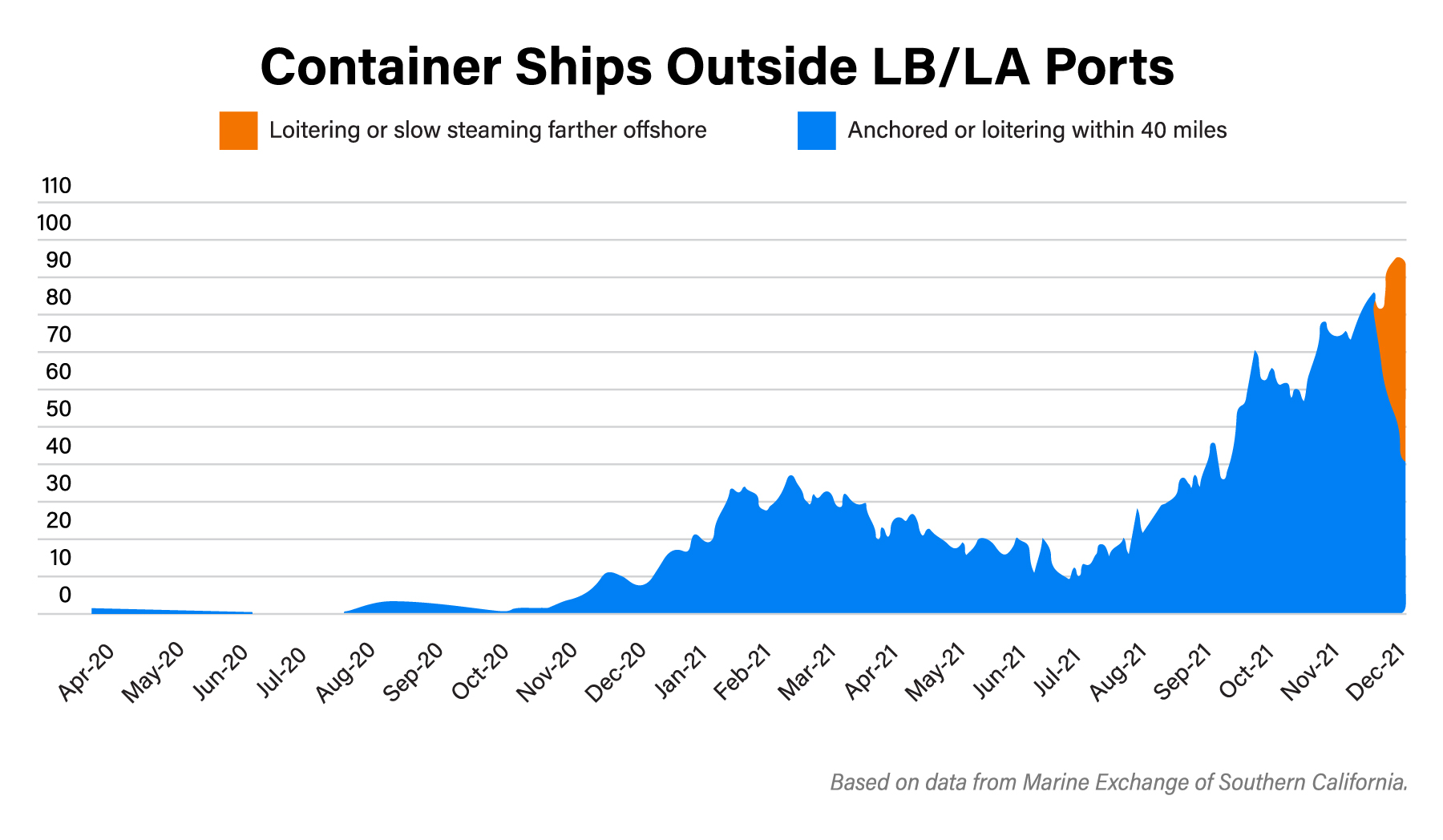
Many conversations have been had in living rooms across the country bemoaning consumer struggles at the grocery store. First, it was toilet paper and then it moved on to meat and chicken. Nowadays, one might be more perplexed by the oddities in what they cannot locate — for example, there’s plenty of Coca Cola but Sprite Zero seems to be getting the short end of the stick on the manufacturing side.
Businesses focus their supply on the more in-demand products when met with labor challenges to production — kind of a “circling the wagons” mentality to ensure the mainstay is available. But labor is one of many obstacles, including materials, transportation, demand, and the much-bemoaned cargo ship debacle outside Los Angeles and Long Beach ports.
Pandemic-related, the ship backup that started in 2020 — before this, ships could almost immediately dock at the port — was steadily chipping down by July 2021. The numbers started climbing again, reaching a peak of 109 ships waiting off the coast in early 2022; that number decreased to under 80 as of mid-February. This much-hoped for break is mainly due to moving past the initial Omicron variant wave of illness allowing labor positions to fill and the Lunar New Year holiday in early 2022 stalling Asian production, allowing for a catch-up period. The cargo ships are laden with everything such as furniture, household products, electronics, and assembly parts — items needed by businesses and consumers. This impacts mobility and IT inventory in the form of laptops, tablets, and smartphones.

Supply chain challenges don’t discriminate between industries like healthcare, automobile, or information technology. These obstacles are rooted in similar problems and issues and often have similar solutions though, according to David Dreyfus. Dreyfus, an assistant professor in the Supply Chain Management Department of Rutgers Business School, earned his Ph.D. in operations and sourcing management and previously worked for Volvo Construction Equipment.
“There’s a lot of overlap,” he said. “It’s not IT only or healthcare only; it just shifts around.”
Shortages with chips, which are used in many electronics from computers to automobiles, can be compared to the consumer grocery products mentioned earlier. As the need went down in the early pandemic stages, manufacturers turned to the production of more profitable and in-demand products. Once things settled and demand returned, chip manufacturers were slow to deliver because of other products they were producing, labor shortages at every stage from inception to delivery, and because they felt the chip technology — while in demand — was out of date.
“You can’t switch chip manufacturers quickly. It requires rigorous testing and development that takes months or years,” Dreyfus said. “Before Omicron, there was a light at the end of the tunnel in terms of the supply chain, and this started the conversation for chip upgrades to car manufacturers. You can’t switch chip manufacturers quickly though because it requires rigorous testing and development that takes months or years.
“There is some truth that manufacturers relied on older chip technology because they knew it was reliable,” Dreyfus said. “They had a robust and proven track record and can be made cheaply. The organizations using the chips were reluctant to rock the boat on integration in this area. Simply put, it’s often hard to try something new when you know it’s reliable.”
Dreyfus anticipates that eventually the backorder of technology will return to pre pandemic supply/demand, but cautions interest rates may on the rise. Investing in more sophisticated chip technology can already be seen, he pointed out, with Intel’s investment in a new Ohio factory promising 3,000 jobs within the next three years.

Organizations looking at supply chain use cases that allow them to avoid pitfalls of delayed production on their end or predict shortages with needed technologies can take a page from Apple’s notebook. While Apple’s approach may make duplicating difficult because of the sheer expense, valuable lessons can be taken. Apple’s vertically integrated supply chain is unique and separates it from competitors like Dell, Dreyfus noted.
“For Apple, they have a vertically integrated supply chain that isn’t seen by competitors. When Apple comes up with a new phone in the fall with slightly different technology, they work with their suppliers and buy out the supply chain,” Dreyfus said. “Their primary supplier is Foxconn, located in China, and they have a long investment history with each other. If Apple’s new phone comes out with Gorilla Glass, how will they ensure nobody else gets it? They buy up every piece that’s going to be made. They can go straight to the factory, ask how much they can make, and buy it all up.” ‘ The same mentality is applied to shipping products from Asia, where it has come to be expected that Apple will buy up the airport flights for two weeks in a row. Dreyfus said this practice has been going on so long, it can largely be predicted by other businesses and is less disruptive. A tricky part in Apple’s playbook is that its largest supplier — Samsung — is also its largest competitor.
“Supply chains are complex and that’s what makes this topic so interesting,” he said, following up with some recommendations during this challenging time. “These are great tactics to revisit your use.”
Securing supply: “One of the first steps is securing the supply. To do so, you have to consider your organization’s size, relationships with suppliers, and how much money you have. Look at your suppliers and rethink your mobile choices that open up suppliers. With computers, are you always using Dell but having trouble with supply? Look to other manufacturers to get your computing needs. You might pay more and sometimes you can’t find anything.
Reduce, reuse, recycle: “When resources are scarce, we look to our sustainability models: reduce, reuse, recycle. Can we reduce the amount we’re using, can we use them all, can we reuse what we have? The last resort is to recycle or buy new or from another company.
Adapt workspace: “You may want to consider sharing desks and equipment. Use a desktop for one employee if another has laptop access.”
Reduce equipment: “One approach to reducing use is a dumb terminal, screen, keyboard, and mouse that work off a central computer. At the same time, consider what you are sacrificing and the risks of implementing this approach. Security and data concerns need to be addressed and internet reliability is key.
“When recalling the Japanese tsunami in 2009 that wiped out factories, there was a lag time to get a new supplier on board with a specialized product. Manufacturers took old equipment, refurbished it, and put it on new equipment, making it “new” again.”
Back to basics: “There’s also the option to just do without, as car manufacturers have been doing recently. They’re selling basic models with the option to return for upgrades when available.
“Do I need the fanciest, latest gadget? Do we need all the bells/whistles in options? From the laptop or phone perspective, make a conscious decision to purchase a basic version and know replacement will occur more frequently.”
Supply isn’t a one-way street and you must consider your business output while considering your supply chain, Dreyfus said. “On the customer end, take the example your own go-to suppliers are offering you. Reuse what you have or move production closer to home. Be sure to set new expectations early and offer something for their patience, like moving forward on other deliverables.”
Moving production closer to home or joint ventures are other tactics seeing increased adoption, as seen by hospitals partnering with personal protection equipment suppliers to guarantee their supply.
Dreyfus, who also goes by the moniker “The Supply Chain Professor,” closed with the thought that while he understands many companies are struggling, “It’s fascinating looking inside at all the different responses to the supply challenge.”
How can we help?
Normal business hours are 8:00am to 5pm EST, Monday to Friday.
©2024 AOTMP University. All rights reserved.
"*" indicates required fields